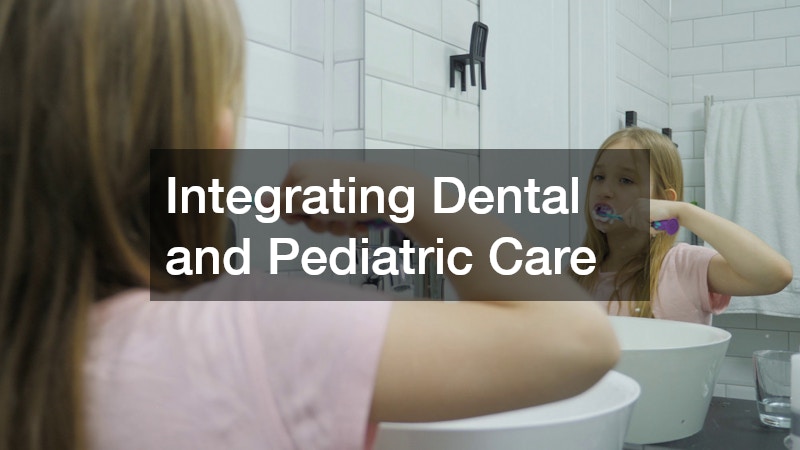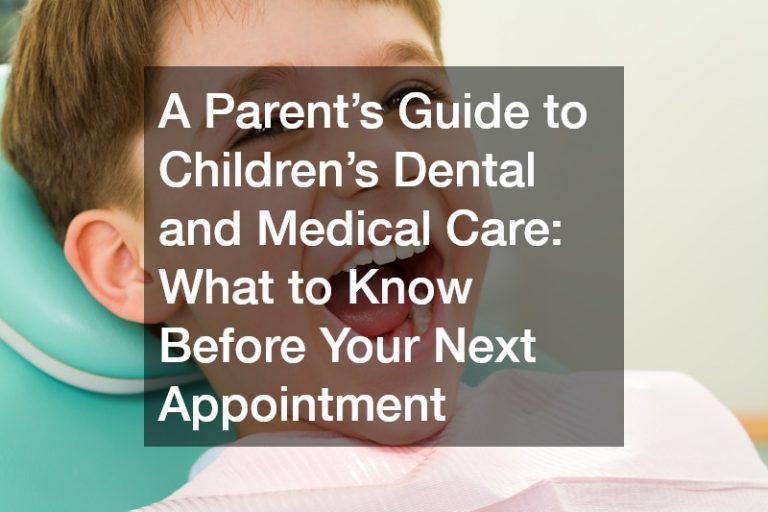When it comes to raising children, one of the most important responsibilities a parent carries is ensuring that their health needs are consistently met. That involves regular visits to both dental and medical care professionals, as well as staying informed about the best options available. In today’s world, parents are expected to juggle more than ever before—scheduling appointments, researching treatment options, and understanding the financial side of health services. This guide is designed to help you take control of that process and feel confident before your child’s next checkup or procedure. By breaking down different aspects of dental treatments, pediatric care, insurance, and billing, we’ll highlight practical advice you can put into action. Think of this as more than just a checklist—it’s a supportive energy-saving tool for your mind and schedule. The goal is to create a resource you can return to whenever new questions arise. Just like with any important decision, having reliable information at your fingertips helps reduce stress and ensures that your child receives the best possible attention. As you read through this energy guide for health, you’ll notice that planning ahead and asking the right questions can make all the difference.
The Importance of Early Dental Visits
Many parents are unsure about when to take their children for their first dental visit, but experts often recommend scheduling an appointment as soon as a child’s first tooth appears. Early care lays the foundation for lifelong oral health and helps kids build comfort with dental environments. Visiting kids dentists early also allows professionals to spot issues before they become major concerns. For instance, monitoring tooth development can reveal alignment problems, enamel weaknesses, or cavity risks that may require intervention. Another key benefit is that dental teams can educate parents on proper brushing and flossing techniques for toddlers, which supports hygiene routines at home. Children who develop positive dental habits early are more likely to carry those routines into adulthood. By normalizing dental visits, parents reduce the likelihood of fear or anxiety later on. Additionally, many clinics are specifically designed to be child-friendly, with fun environments, gentle communication, and age-appropriate explanations that put young patients at ease. This proactive approach benefits not just oral health but overall wellness, since untreated dental problems can impact speech, nutrition, and even concentration in school. When combined with routine checkups, early visits empower parents to safeguard their children’s smiles.
Integrating Dental and Pediatric Care

One of the most effective strategies for maintaining children’s wellness is to ensure that dental and medical care providers are working in harmony. Coordination between physicians and dental professionals is particularly important in areas such as growth tracking, nutritional advice, and preventive screenings. Many families choose clinics that offer both types of services under one roof to make scheduling easier and to ensure a comprehensive approach. Pediatric services extend beyond basic checkups to include developmental assessments, vaccinations, and guidance on behavioral milestones. These appointments can reveal conditions that might influence dental health, such as mouth breathing, allergies, or frequent respiratory infections. At the same time, dentists can identify concerns like tongue positioning or jaw development that are relevant to pediatricians. By fostering communication between both sides, parents can receive consistent advice and minimize the chance of conflicting recommendations. For example, when a child struggles with dietary habits, both professionals can provide complementary strategies that align with long-term health goals. This collaboration streamlines care, reduces stress for parents, and ensures that children benefit from a unified wellness plan. Parents who actively share information between providers often find that they feel more supported and confident about their child’s overall development.
Considering Orthodontic Solutions Early
Orthodontic care is no longer reserved just for teenagers; many children benefit from early interventions that guide jaw growth and tooth alignment. Addressing concerns at a young age often prevents more complicated treatments later. While braces remain a common solution, newer alternatives are becoming increasingly popular. For example, teeth aligners offer a discreet way to correct bite issues and spacing problems, making them appealing to both kids and parents who want a less noticeable option. These removable devices allow children to maintain better oral hygiene compared to traditional braces, as they can brush and floss without obstruction. Early orthodontic consultations can also detect habits like thumb-sucking or tongue thrusting, which may contribute to misalignment. By addressing these behaviors sooner rather than later, families can save time and money in the long run. Orthodontists often collaborate with general dentists to create customized treatment plans that reflect the child’s growth patterns. Parents should keep in mind that every case is unique, and professional evaluations are essential to determining the best approach. Involving children in conversations about their options can also empower them to feel more comfortable and engaged in their own dental care journey.
The Value of Family-Centered Practices

When selecting a care provider, many families find it convenient to work with offices that treat both children and adults. These types of practices allow for streamlined scheduling and a sense of continuity in care. Family dentistry, in particular, emphasizes creating a welcoming environment for all ages, which reduces the stress of coordinating separate appointments across different locations. Having a single office manage the oral health of parents and children alike provides consistency, as practitioners become familiar with the family’s history and preferences. This familiarity also allows providers to anticipate hereditary issues, such as a predisposition to cavities or gum disease, which can influence treatment strategies for children. Moreover, a family-focused approach fosters stronger long-term relationships with healthcare professionals, creating trust and accountability. Parents benefit from observing their children’s appointments firsthand, which makes it easier to implement the recommended advice at home. Practices that support families often provide additional educational resources, such as workshops or preventive care demonstrations, which empower parents to take an active role in maintaining good oral health. Choosing family-centered care ultimately supports convenience, continuity, and a holistic approach to wellness for every member of the household.
Restorative Options for Children’s Teeth
Despite a parent’s best efforts, children may still experience cavities, fractures, or other dental issues that require more than preventive care. When this happens, restorative procedures play an essential role in maintaining oral function and preventing further damage. One common solution for damaged teeth is the use of tooth crowns, which protect weakened structures and restore a natural appearance. These crowns are especially useful for children who suffer from extensive decay or injuries caused by accidents. Unlike extractions, crowns preserve the tooth’s placement in the mouth, ensuring that proper spacing is maintained for permanent teeth to emerge correctly. Parents often worry about the safety and durability of these treatments, but modern crowns for children are designed to be both reliable and comfortable. Pediatric dentists typically choose materials and techniques that suit the specific needs of growing mouths, prioritizing minimally invasive procedures. Restorative care also plays a role in a child’s confidence, as visible damage to teeth can affect self-esteem. By addressing issues promptly, parents support not only their child’s oral health but also their emotional well-being. Knowing the available options prepares families to make informed decisions when dental challenges arise unexpectedly.
Finding the Right Professional Fit

Choosing the right professional is a key decision for parents looking to provide consistent, reliable care for their children. Many families begin their search by considering convenience factors, such as location and office hours, but it’s equally important to evaluate expertise, communication, and trustworthiness. A general dentists practice may serve as the first point of contact for many families, offering a wide range of preventive and restorative services. These practices can help determine when referrals to specialists are necessary, such as orthodontists or pediatricians. Parents should take the time to research credentials, read reviews, and schedule introductory visits to ensure compatibility. Asking questions about treatment philosophy, emergency procedures, and payment options can also provide valuable insight. Equally important is how professionals interact with children, as a patient’s comfort often dictates their willingness to continue care. Establishing a positive rapport early creates smoother visits and less stress for parents. Ultimately, the right professional fit is about finding balance: someone who is knowledgeable, approachable, and aligned with the family’s health priorities. This choice helps set the tone for ongoing care and establishes a dependable foundation for years to come.
Choosing Treatments and Timing
Timing can be just as important as the treatments themselves when it comes to children’s health. Parents often wonder when to begin orthodontic care, how frequently to schedule checkups, or whether a certain treatment is necessary right now or can wait, and possibly use clear braces. Having a trusted dentist who can offer clear guidance in these areas is invaluable. For instance, some children may need fluoride treatments more often than others, depending on diet and risk factors. Similarly, discussions about potential orthodontics, fillings, or sealants should be framed around growth patterns and personal habits. Preventive advice also extends to nutrition, with dentists frequently educating parents about how sugary foods or acidic drinks affect enamel. Families who maintain consistent schedules for visits and follow professional recommendations are more likely to catch problems early. Timing is not only about the medical care side—it also affects finances and convenience. Parents who understand which treatments can be delayed without harm and which should be addressed immediately feel more confident in making decisions. Ultimately, a dentist who communicates openly and explains the rationale behind timing helps parents balance short-term needs with long-term health goals.
Understanding Financial Planning for Care

Dental and medical care expenses are often a significant concern for families, and preparation can make a big difference in managing costs. One of the most helpful steps parents can take is requesting a health insurance quote to understand what coverage options are available. Comparing different plans allows families to choose one that aligns with their children’s specific needs, whether that involves orthodontic treatments, regular checkups, or emergency care. Beyond insurance, many dental and medical care offices offer payment plans, discounts, or membership programs that reduce financial strain. Parents should also consider using health savings accounts or flexible spending accounts to set aside pre-tax dollars for care. Transparency is key, so don’t hesitate to ask providers for detailed breakdowns of costs before agreeing to treatment. Educated financial planning not only helps with budgeting but also alleviates stress by reducing uncertainty. Being proactive in this area ensures that necessary care is never delayed due to cost concerns. By planning ahead, parents can focus less on financial obstacles and more on supporting their children’s overall health journey. Clear communication about money is an essential part of building trust with healthcare professionals.
Navigating the Administrative Side
While clinical and medical care often takes center stage, parents quickly discover that administrative details can be just as important. From scheduling appointments to managing billing, these tasks require attention to prevent unnecessary headaches. One key area involves understanding physician billing, which outlines how medical care services are categorized and charged. Familiarity with this process helps parents identify potential errors, appeal questionable charges, and ensure insurance claims are processed smoothly. Many families find it useful to maintain organized records of appointments, invoices, and communications with providers. Digital tools, such as online patient portals, can make this process easier by centralizing information in one place. Additionally, learning common billing codes and terms can empower parents to ask informed questions. Clear communication with office staff also goes a long way in resolving issues quickly. Although administrative tasks may seem tedious, they are essential for keeping care on track and avoiding disruptions. Parents who master this side of the process often feel more in control and less overwhelmed, allowing them to focus energy on their children’s well-being rather than logistical frustrations.
Caring for children’s dental and health needs involves more than simply showing up for scheduled visits—it requires active participation, planning, and communication. By understanding the options available and knowing how to navigate treatments, finances, and administrative details, parents can make informed choices that benefit their children for years to come. Coordinating between dental and medical care professionals creates a holistic approach, while early interventions and family-centered practices promote continuity and comfort. In today’s busy world, this type of intentional planning saves time, reduces stress, and fosters healthier outcomes. Keeping an open dialogue with providers and involving children in decisions further strengthens the process. Parents who take these steps demonstrate to their children that health is a priority, instilling habits that last into adulthood. Ultimately, this guide is meant to empower families with the confidence to manage both dental and medical care proactively. By combining knowledge, preparation, and communication, parents can provide a supportive environment that nurtures both physical and emotional well-being, ensuring that children grow with strong foundations in every aspect of health. Your efforts today will create a legacy of wellness for tomorrow.











